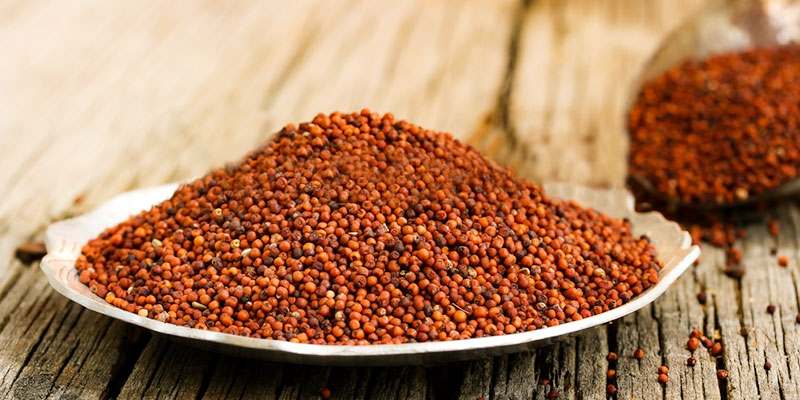Benefits and Side Effects of Ragi

Introduction
Are you eager to know about the advantages and disadvantages of Ragi?
Then don’t worry! You’re on the right page.
Ragi is an ancient and famous grain mostly popular in India. The scientific name of Ragi or Finger Millet is Eleusine coracana. It was mainly used in the southern part of India. But nowadays people have started using ragi regularly in their diet. Ragi has a lot of nutritional and therapeutic value which is helpful for the human body.
Ragi is a crop that is adapted to most Indian climatic conditions. Finger Millet originated in East Africa (Ethiopian and higher regions of Uganda) and arrived in India around 2000 BC.
In this article, we will discuss the benefits and side effects of ragi.
Avertisement
What Is Ragi?
Ragi is a nutritionally rich grain that contains 6.7% high-quality protein. The grain is gluten-free and is suitable for those who are gluten or lactose intolerant. In addition, it can easily become a part of your daily diet in the form of chapatis or as oatmeal for breakfast.
It has a soft taste and resembles mustard seeds. Ragi can be made either by itself or by mixing it with other cereal flours like jowar, millet, and whole wheat to make a variety of breakfast dishes such as ragi idli, dosa, and upma.
Avertisement
How to Consume or Use Ragi?
There are many ways by which you can use ragi. These are the following:
1) Ragi is good for infants and young children. Soak the right amount of ragi in water and make ragi porridge for them and then grind it. Take out the milk of ragi and then cook it in ghee till it thickens. Then add salt, sugar, and milk. If your kids don’t like it, mix it with some dry fruits. Try this for yourself and you will love it.
2) Make ragi roti with curd, ragi, wheat, and spinach.
3) Prepare guilt-free calcium-rich cookies with the goodness of ragi and sugarcane sugar.
4) Make idli or dosa by mixing rice and ragi in equal quantities.
5) Do you like pudding very much? They do not make it for fear of getting fat, then just make it with ragi and enjoy.
Let us see what are the advantages and disadvantages of ragi.
Avertisement
Benefits of Ragi
Ragi is a super grain that has many health benefits for us. They are high-fiber and nutritious food which is full of good carbohydrates. Let us know the benefits of ragi.
1. Ragi is Good for Diabetes
Diabetes is a very common disease today where the blood sugar level increases. The substances present in ragi control the sugar level in your body. This helps diabetics keep an eye on their sugar levels. Incorporate ragi in your diet. Take ragi for breakfast or lunch so that you can monitor your sugar level.
2. Ragi Helps in Anemia
Patients who are suffering from anaemia have an iron deficiency. And, their haemoglobin levels begin to fall. Ragi is a good iron source. Anyone suffering from anaemia can incorporate ragi so that they see a significant jump in their haemoglobin.
3. Ragi Can Slow Down Process of Aging
Ragi makes you look younger than your age. It has antioxidant properties that prevent the cross-linking of collagen. The higher the level of collagen, the lower the signs of ageing. So ragi can help you reduce skin and wrinkles which is the primary sign of ageing.
4. Ragi Helps in Weight Loss
Many people in the world suffer from obesity and excessive weight gain. This is a growing concern. To lose weight people try various exercise and dietary patterns such as keto and intermittent fasting. But they sometimes fail miserably. Ragi is rich in amino acids and thus helps in reducing stubborn fat in our bodies. Since ragi are also rich in fibre, you feel less hungry. To get maximum benefit, consume ragi for breakfast.
5. Ragi is Good for High Blood Pressure
In its early stages of development, when it is still green, ragi can help prevent hypertension. You can make rotis with ragi and watch it regularly with a drop in your blood pressure level soon. Make sure you ragi at the same time every day to see visual results.
6. Ragi is Good For Strong Bones
We need calcium to make bones strong and ragi have more calcium than other popular grains. Calcium is necessary to prevent bone-related diseases such as osteoporosis and bone growth. You may have calcium supplements for these problems but ragi can be a natural way to relieve and reap its benefits.
7. It Is Good for Nursing Mothers
If you are a lactating mother and you breastfeed your baby. Then, you should include green ragi in your diet as it can increase the milk of mothers. It can also enhance milk with essential amino acids, iron, and calcium. It is good for the health and development of the child.
8. Ragi Helps with Food Intolerance
If you are gluten or lactose intolerant then ragi is a great dietary option instead of wheat. Ragi is a rich source of good carbohydrates and is gluten-free and suitable for people who are gluten intolerant. Ragi flour is also one of the best non-dairy sources of calcium. So if you are lactose intolerant then consume ragi instead of milk.
Avertisement
Side Effects of Ragi
Ragi is very beneficial for us but you should control your portion size. Excess intake can increase the amount of oxalic acid in the body. Due to this, ragi is also not recommended for kidney patients. If you face any issues with Ragi, please consult your physician for the necessary actions.
Avertisement
Frequently Asked Questions About Ragi
1. Can ragi be eaten daily?
Ans: One or two helpings of ragi flour are eaten daily. Ragi is low in fat and an adequate source of protein. Regular intake of ragi promotes optimum weight and controls blood sugar. Since ragi is a rich source of calcium, its excessive intake can cause kidney stones. Ragi has controlled parts to avoid side effects.
2. What is the English name of Ragi?
Ans: Ragi is called finger millet in English. And, it ranks sixth in production after wheat, rice, maize, sorbet, and millet in India.
3. Is ragi better than wheat?
Ans: Ragi is low in fat content as compared to other grains. This fat is unsaturated fat which is a more healthy option. So you can easily substitute it for wheat and rice if your primary goal is to lose weight.
4. Can you eat ragi at night?
Ans: For a good night’s sleep, you can eat ragi at night. Complex carbohydrate-rich foods such as oats, barley, ragi, when consumed with a glass of low-fat milk at night, can reduce sleep and sleepiness.
5. Are ragi and bajra the same?
Ans: Millet can be cooked in the form of grains and it can be mixed to form a multipurpose flour, which ranges in nature from rotis to patties, bread, etc. Both Ragi and Bajra belong to the same family.
6. Does ragi cause constipation?
Ans: Consumption of grains like millet, ragi, and millet may sometimes cause an immune response. It can destroy the lining of the small intestine. This can then lead to issues such as bloating, gas, diarrhoea, haemorrhoids, and constipation. Therefore, consult your doctor before intake.
Also Read: Chia Seeds Benefits And Side Effects
Avertisement
Conclusion
You already know that ragi is a great source of calcium and it can help with many health problems like weight gain, high blood pressure, anaemia, etc. We hope that this article has helped you understand the advantages and disadvantages of ragi. Now you can go ahead and try to include ragi in your daily diet.
Did you like this article? Did we give you enough information? Then share it with your friends and family. And, don’t forget to mention it in the comments section below.




Responses